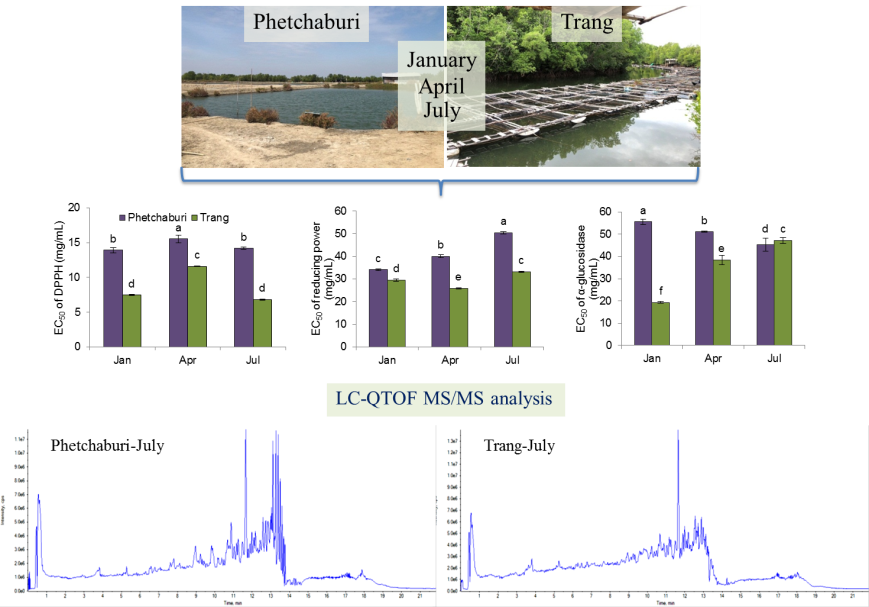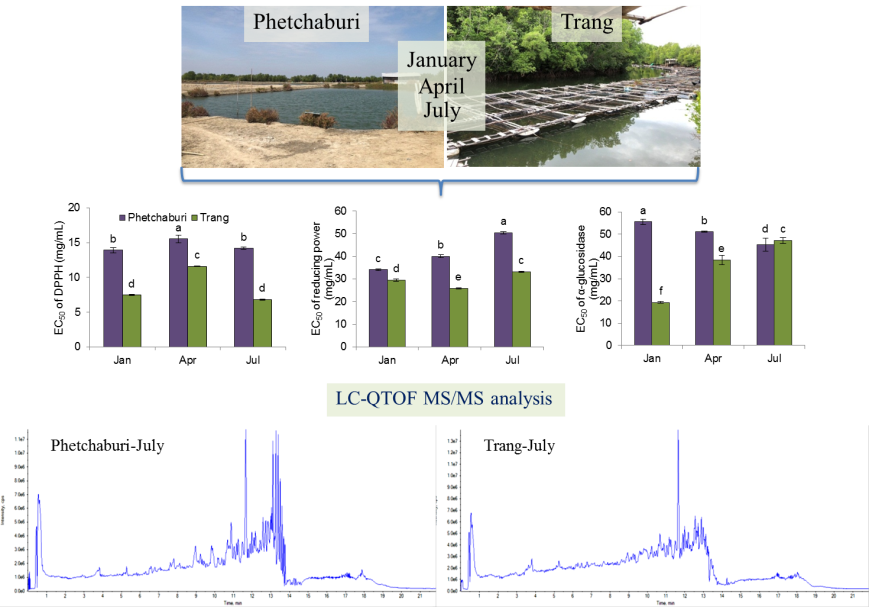Chemical Profile, Antioxidant Activity and α-Glucosidase Inhibition of Sea Grape Caulerpa lentillifera Collected from Different Sites in Thailand
DOI:
https://doi.org/10.48048/tis.2024.7520Keywords:
LC-QTOF MS/MS analysis, Metabolite, Phenolic compound, SeaweedAbstract
Caulerpa lentillifera (sea grapes) stands out for its nutritional profile and associated health advantages. Seaweeds, including sea grapes, exhibit diverse chemical compositions that are influenced by environmental conditions. This study aimed to compare the chemical composition, metabolite content, antioxidant activity and α-glucosidase inhibition of sea grapes collected at different sites (Phetchaburi and Trang) and at different times during the month of January, April, and July 2022. Both collection times and sites have influenced all assessed parameters. The sea grapes collected from Trang had a significantly higher amount of metabolite, antioxidant activity and α-glucosidase inhibitory activity than those from Phetchaburi at p < 0.001. The highest amount of phenolic compound (93.76 ± 2.39 mg GAE/g extract) and reducing power (EC50 = 25.86 ± 0.20 mg/mL) occurred in sea grapes in April month, while those collected in January and April had high DPPH and ABTS radical scavenging (EC50 < 7.50 mg/mL). The highest inhibitory activity against α-glucosidase (EC50 = 19.27 ± 0.40 mg/mL) was found in the sea grapes collected in January. The LC-QTOF MS/MS result of sea grape extract indicated similar compounds in amino acids, fatty acids, lipids, nucleic acids, carboxylic acids, cyanogenic glucosides, steroids, terpenoids and vitamins. The disparity in phenolic profiles between Phetchaburi (9) and Trang (14) sea grapes was related to higher phenolic compound and flavonoid contents, coupled with antioxidant properties in Trang. These findings supported the possible use of sea grapes from Trang as a reservoir of bioactive compounds.
HIGHLIGHTS
- Chemical profile and content, antioxidant and α-glucosidase inhibition of sea grapes was analyzed
- Collection times and sites affected all measured parameters of sea grapes extract
- Sea grapes from Trang exhibited higher all measured parameters than Phetchaburi
- A novel chemical profiling of sea grapes was displayed via LC-QTOF MS/MS analysis
GRAPHICAL ABSTRACT
Downloads
Metrics
References
B Choudhary, OP Chauhan and A Mishra. Edible seaweeds: A potential novel source of bioactive metabolites and nutraceuticals with human health benefits. Front. Mar. Sci. 2021; 8, 740054.
M Zubia, SGA Draisma, KL Morrissey, E Varela-Álvarez and OD Clerck. Concise review of the genus Caulerpa J.V. Lamouroux. J. Appl. Phycol. 2020; 32, 23-39.
C Gaillande, C Payri, G Remoissenet and M Zubia. Caulerpa consumption, nutritional value and farming in the Indo-Pacific region. J. Appl. Phycol. 2017; 29, 2249-66.
X Chen, Y Sun, H Liu, S Liu, Y Qin and P Li. Advances in cultivation, wastewater treatment application, bioactive components of Caulerpa lentillifera and their biotechnological applications. PeerJ 2019; 7, e6118.
P Matanjun, S Mohamed, NM Mustapha and K Muhammad. Nutrient content of tropical edible seaweeds, Eucheuma cottonii, Caulerpa lentillifera and Sargassum polycystum. J. Appl. Phycol. 2009; 21, 75-80.
N Syakilla, R George, FY Chye, W Pindi, S Mantihal, NA Wahab, FM Fadzwi, PH Gu and P Matanjun. A review on nutrients, phytochemicals, and health benefits of green seaweed, Caulerpa lentillifera. Foods 2022; 11, 2832.
VT Nguyen, JP Ueng and GJ Tsai. Proximate composition, total phenolic content, and antioxidant activity of seagrape (Caulerpa lentillifera). J. Food Sci. 2011; 76, C950-C958.
S Osotprasit, T Samrit, A Chaiwichien, N Changklungmoa, K Meemon, N Niamnont, P Manohong, K Noonong, M Tamtin, P Sobhon and P Kueakhai. Toxicity and anti-oxidation capacity of the extracts from Caulerpa lentillifera. Chiang Mai Univ. J. Nat. Sci. 2021; 20, e2021065.
BR Shama, HJ Kim and DY Rhyu. Caulerpa lentillifera extract ameliorates insulin resistance and regulates glucose metabolism in C57BL/KsJ-db/db mice via PI3K/AKT signaling pathway in myocytes. J. Translat. Med. 2015; 13, 62.
R Maeda, T Ida, H Ihara and T Sakamoto. Induction of apoptosis in MCF-7 cells by β-1,3-xylooligosaccharides prepared from Caulerpa lentillifera. Biosci. Biotechnol. Biochem. 2012; 76, 1032-4.
V Tanawoot, P Vivithanaporn, T Siangcham, K Meemon, N Niamnont, P Sobhon, M Tamtin and K Sangpairoj. Hexane extract of seaweed Caulerpa lentillifera inhibits cell proliferation and induces apoptosis of human glioblastoma cells. Sci. Tech. Asia 2021; 26, 128-37.
AR Arenajo, AP Ybañez, MMP Ababan, CE Villajuan, MRM Lasam, CP Young and JLA Reyes. The potential anticoagulant property of Caulerpa lentillifera crude extract. Int. J. Health Sci. 2017; 11, 29-32.
T Nagappan and CS Vairappan. Nutritional and bioactive properties of three edible species of green algae, genus Caulerpa (Caulerpaceae). J. Appl. Phycol. 2014; 26, 1019-27.
D Daud, NFM Arsad, A Ismail and A Tawang. Anti-pyretic action of Caulerpa lentillifera, Hibiscus rosa-sinensis and Piper sarmentosum aqueous extract in mice. Asian J. Pharmaceut. Clin. Res. 2016; 9, 9-11.
M Zhang, M Zhao, Y Qing, Y Luo, G Xia and Y Li. Study on immunostimulatory activity and extraction process optimization of polysaccharides from Caulerpa lentillifera. Int. J. Biol. Macromol. 2020; 143, 677-84.
D Daud, AN Zainal, MN Nordin, A Tawang and A Ismail. Chelation activity and protective effect of Caulerpa lentillifera aqueous extract against lead acetate-induced toxicity in Sprague Dawley rats. J. Appl. Pharmaceut. Sci. 2020; 10, 145-8.
HK Lichtenthaler and AR Wellburn. Determination of total carotenoids and chlorophylls a and b of leaf in different solvents. Biochem. Soc. Trans. 1983; 11, 591-2.
VL Singleton, R Orthofer and RM Lamuela-Ravenros. Analysis of total phenols and other oxidation substrates and antioxidants by means of Folin-Ciocalteu reagent. Meth. Enzymol. 1999; 299, 152-78.
J Zhishen, T Mengcheng and W Jianming. The determination of flavonoid contents in mulberry and their scavenging effects on superoxide radicals. Food Chem. 1999; 64, 555-9.
H Li, C Tang, Z Xu, X Lin and X Han. Effects of different light sources on the growth of non-heading Chinese cabbage (Brassica campestris L.). J. Agr. Sci. 2012; 4, 262-73.
J Li, H Liu, MS Mazhar, S Quddus and HAR Suleria. LC-ESI-QTOF-MS/MS profiling of phenolic compounds in Australian native plums and their potential antioxidant activities. Food Biosci. 2023; 52, 102331.
W Brand-Williams, ME Cuvelier and C Berset. Use of a free radical method to evaluate antioxidant activity. LWT Food Sci. Tech. 1995; 28, 25-30.
R Re, N Pellegrini, A Proteggente, A Pannala, M Yang and C Rice-Evans. Antioxidant activity applying an improved ABTS radical cation decolorization assay. Free Radic. Biol. Med. 1999; 26, 1231-7.
BL Su, R Zeng, JY Chen, CY Chen, JH Guo and CG Huang. Antioxidant and antimicrobial properties of various solvent extracts from Impatiens balsamina L. stem. J. Food Sci. 2012; 77, C614-C619.
E Apostolidis, YI Kwon and K Shetty. Inhibitory potential of herb, fruit, and fungal-enriched cheese against key enzymes linked to type 2 diabetes and hypertension. Innovat. Food Sci. Emerg. Tech. 2007; 8, 46-54.
R Core Team. R: A language and environment for statistical computing, R Foundation for Statistical Computing, Vienna, Austria, Available at: http://www.R-project.org, accessed February 2023.
A Pérez-Gálvez, I Viera and M Roca. Carotenoids and chlorophylls antioxidants. Antioxidants 2020; 9, 505.
T Srinorasing, N Chirasuwan, B Bunnag and R Chaiklahan. Lipid extracts from Caulerpa lentillifera waste: An alternative product in a circular economy. Sustainability 2021; 13, 4491.
B Tanna, B Choudhary and A Mishra. Metabolite profiling, antioxidant, scavenging and anti-proliferative activities of selected tropical green seaweeds reveal the nutraceutical potential of Caulerpa spp. Algal Res. 2018; 36, 96-105.
CY Yang, YY Yen, KC Hung, SW Hsu, SJ Lan and HC Lin. Inhibitory effects of pu-erh tea on alpha glucosidase and alpha amylase: A systemic review. Nutr. Diabetes 2019; 9, 23.
KMS Pires-Cavalcante, DB Alencar, MB Sousa, AHS Sampaio and S Saker-Sampaio. Seasonal changes of α-tocopherol in green marine algae (Caulerpa genus). J. Food Sci. 2011; 76, C775-C781.
YY Zhang, SE Yu, WL Wang, LE Yang, QQ Lu, CT Xie, T Liu and YW Dong. Temperature sensitivity of marine macroalgae for aquaculture in China. Aquaculture 2023; 567, 739262.
A Moazzen, N Öztinen, E Ak-Sakalli and M Koşar. Structure-antiradical activity relationships of 25 natural antioxidant phenolic compounds from different classes. Heliyon 2022; 8, e10467.
I Gutiérrez-del-Rio, S López-Ibáñez, P Magadán-Corpas, L Fernández-Calleja, Á Pérez-Valero, M Tuñón-Granda, EM Miguélez, CJ Villar and F Lombó. Terpenoids and polyphenols as natural antioxidant agents in food preservation. Antioxidants 2021; 10, 1264.
Y Tanaka, H Uchi and M Furue. Antioxidant cinnamaldehyde attenuates UVB-induced photoaging. J. Dermatol. Sci. 2019; 96, 151-8.
R Jiang, G Su, X Chen, S Chen, Q Li, B Xie and Y Zhao. Esculetin inhibits endometrial cancer proliferation and promotes apoptosis via hnRNPA1 to downregulate BCLXL and XIAP. Canc. Lett. 2021; 521, 308-21.
X Dong, S Zhou and J Nao. Kaempferol as a therapeutic agent in Alzheimer’s disease: Evidence from preclinical studies. Ageing Res. Rev. 2023; 87, 101910.
DJ Ooi, NH Azmi, MU Iman, NB Alitheen and M Ismali. Curculigoside and polyphenol-rich ethyl acetate fraction of Molineria latifolia rhizome improved glucose uptake via potential mTOR/AKT activated GLUT4 translocation. J. Food Drug Anal. 2018; 26, 1253-6.

Downloads
Published
How to Cite
Issue
Section
License
Copyright (c) 2023 Walailak University

This work is licensed under a Creative Commons Attribution-NonCommercial-NoDerivatives 4.0 International License.






